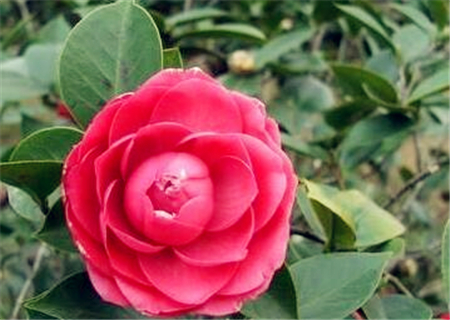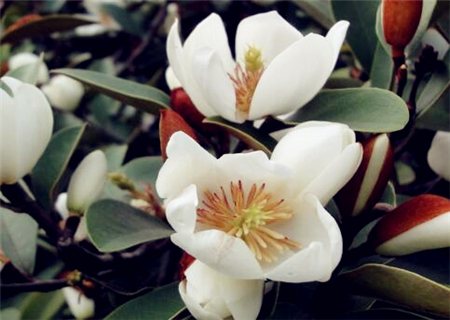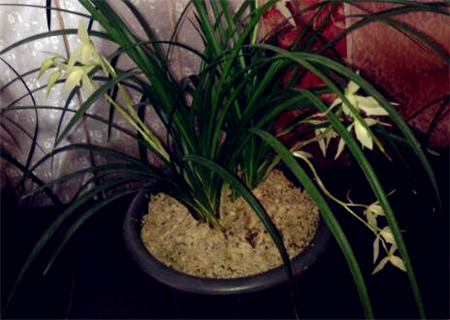When do the "top ten famous flowers" camellia bloom? What season does it belong to? Attach breeding methods and matters needing attention?
Camellia, also known as camellia, has varying degrees of red, purple, white and yellow flowers, and even colored striped camellias. It is a traditional ornamental flower in China. It ranks seventh among the "top ten famous flowers" and is also one of the most valuable flowers in the world. So when do camellias bloom? What season does it belong to? The following is for everyone to sort out the camellia culture methods and matters needing attention.

The blooming time of camellias has a certain flowering period. because of the differences in climate between the north and the south and the influence of heating in some parts of the north, generally speaking, in the south, they usually bloom from March to April. Of course, some varieties blossom early and some bloom late. The most suitable temperature for camellia flowering is 22 degrees Celsius 25 degrees Celsius.
The climate in the north is colder, and flowering may be delayed. However, the indoor temperature is higher, it is possible to bloom ahead of time, for example, some flower friends' camellias began to bloom at the end of November!
In short, let it blossom naturally, in general, do not use drugs to promote flowers, if there are too many buds, you can pick some in order to concentrate nutrients and bloom well.
Growth habits of Camellia
Understand the flower language of camellia, and then take a look at the environment in which camellia adapts to its growth. Found in China, Zhejiang, Jiangxi, Sichuan and Shandong; also distributed in Japan and the Korean Peninsula. Camellia is a common shrub or small tree. Like the half-overcast and avoid the scorching sun. Like the warm climate, the suitable temperature for growth is 18 Mel 25 ℃, and the initial flowering temperature is 2 ℃. It is slightly cold-tolerant, and the general variety can withstand low temperature and heat tolerance of-10 ℃, but the growth is inhibited when it exceeds 36 ℃. Camellia likes high air humidity and avoids drying, so it is suitable to grow in areas with annual precipitation above 1200mm. Camellia prefers fertile, loose and slightly acidic soil, and the best PH is 5.5 Murray 6.5.
Camellia has a beautiful crown, bright green leaves and bright flowers. It can not only be planted in the courtyard to do ornamental flowers, beautify the environment, but also be used to decorate the living room, bedroom and study, so that the living room presents an elegant and luxurious atmosphere.
Camellia is an evergreen shrub of the family Camellia. The florescence varies with different species, with flowers blooming from October to April of the following year. The capsule is round and mature at the end of autumn, but most double flowers are sterile. Camellia has the proud plum style of "only camellia is very durable, only the deep moon can occupy the spring breeze", and the bright Ling peony of "flowers are numerous and bright red, deeply seizing Xiaoxia", so it has been a very famous woody flower since ancient times. it reached an unprecedented level in the Tang and Song dynasties, and became a sensation after it was introduced to Europe in the 17th century, thus gaining the reputation of "international famous flowers".
Therefore, every time I walk through a flowering tree, I have to be surprised and hold my breath at the beauty of life. This is a prose written by the poet Xi Murong, which contains only more than 200 words. The quality of the article does not lie in the length, but the artistic conception it conveys is profound and intriguing.
Culture methods and matters needing attention
Camellia like cool weather, afraid of high temperature and heat, when forced to fertilize after the beginning of spring, must be poured alum fertilizer water. The production of alum fertilizer water is to add 100g green to 10kg of water, 200g bean cake powder and 1000 g dried poultry dung. Soak for 1 month when it is hot, and mature after 4 months when it is cool.
(1) cutting
The suitable period for cutting in East China is the middle and late June. The second cuttage was carried out from late August to early September. The temperature in these two periods is about 30 °C, and the temperature can be controlled at about 25 °C by shading facilities. The cuttings should select the current year's semi-mature branches with abundant external tissue of the crown, intact leaves, full leaf buds and no diseases and insect pests. The length of cuttings is generally 4~10cm, with 2 leaves at the apex and a heel on the lower part when cutting. Cutting density generally row spacing 10~14cm, plant spacing 3~4cm, require leaves to hand over each other but not overlap, cuttings into the soil about 3 cm, shallow rooting is fast, deep rooting is slow, after cutting to spray water. It usually takes about 30 days from cuttage to rooting. The key to survival is to maintain sufficient humidity in the early stage of cutting, take measures to reduce hot air convection, avoid direct sunlight, and pay attention to spraying water on the leaf surface, so that the leaf surface is often covered with a thin water film. After taking root, we should gradually increase the sunlight, and after October, we should make the seedlings fully accept the sun and accelerate Lignification.
(2) grafting
Seedling rootstock bud grafting, seeds sown in the sand bed after about 2 months of growth, seedlings as high as 4~5cm, can be dug and grafted by split grafting. The scion chooses well-growing semi-lignified branches, one bud and one leaf from the bottom to the top, and cut one by one. Cut the scion into a positive wedge and put it in a wet towel. Remove the mud and sand from the seedlings, then cut them at the 1~1.5cm above the cotyledons, and cut the stem longitudinally with a suture, the depth of which is the same as the slope cut by the scion; insert the cut scion into the split of the rootstock, aim at one side to form a layer, and tie it tightly with camellia with plastic film. The grafted seedlings were planted in the seedbed with the row spacing of 8cm × 2cm.
It is appropriate to use rich and loose sandy loam on the bed. After planting, the nursery bed should be insulated in a plastic shed, which usually begins to heal in 10-15 days, and the film can be opened at night in 20-25 days to make it ventilated. Then gradually strengthen the ventilation, appropriately increase the light, to the new sprouting, all remove the film. Semi-mature branch grafting, using coarse camellia or Camellia oleifera adult plants as rootstocks to reduce abdominal grafting, can be cultivated into large-scale plants of famous camellia species within 1-2 years.
The plants with healthy plants, full bud eyes and no diseases and insect pests were selected as rootstocks, trimmed in summer before the end of February and in autumn in the first and middle of June to cut off diseased weak branches, drooping branches, cross branches and over-dense branches. The suitable temperature for grafting is 5-30 ℃. Pull skin grafting is used for branches more than 1 cm in diameter, that is, in the appropriate part of the rootstock, a knife is carved on the top, left and right, reaching to the xylem, pulling down the skin, and its length is the same as the cutting face of the scion, then stick the cut scion on the peeling place of the rootstock, pull the skin on and wrap the scion, then tie it with plastic tape, expose the buds, and then cover it with a plastic bag to increase humidity and promote healing. Wait for the scion to pull out the new tip, gradually Lignification, release the binding. The cutting of the rootstock was carried out three times, the first time cutting off the top of the tip during binding, the second time cutting off the upper part of the rootstock after the first shoot of the scion was fully lignified, and the third time after the second shoot of the scion was fully lignified, cut off the rootstock at the interface. The success of grafting in high temperature season depends on the control of high temperature. A shade shed and double curtains must be built so that there is basically no direct sunlight in the shed, and water should be sprayed around noon to cool down, so that the local temperature can be controlled at about 30 °C.
(3) sowing
In October, early and mid-October, put the harvested fruit in an indoor ventilated place to dry, wait for the capsule to crack and take out the seed, sow immediately. If you cannot sow seeds immediately in autumn, you need to hide them in sand and sow them in February of the following year. Seeds can be mixed with new high-fat membrane before sowing, and the germination rate of autumn sowing is higher than that of spring sowing.
Cutting, grafting, striping, sowing and tissue culture are commonly used.
Cutting propagation:
It is the most suitable around the middle of June and the end of August. The semi-mature branches of the same year with abundant external tissue, complete leaves and full leaf buds were selected as cuttings with long 8~10cm and 2 leaves at the apex. When cutting, the base takes a little old branch as far as possible, it is easy to form callus after insertion, and the root is fast. Cuttings cut early in the morning, to cut along with the cutting, insert the substrate of about 3 cm, cuttings require leaves to hand over each other, after cutting with fingers. It is better to insert it shallowly, so that it can heal and take root quickly. The inserting bed should be shaded, spray the leaf surface every day, keep it moist, keep the temperature at 20: 25 ℃, heal about 3 weeks after insertion, and take root after 6 weeks. Transplant into pot when the root is 3~4cm. When cutting, 0.4% 0.5% indolebutyric acid solution was dipped in the base of the cuttings for 2-5 seconds, which could obviously promote rooting.
Grafting propagation:
It is often used for varieties with difficulty in rooting or few propagation materials. The survival rate of grafting was the highest when the new shoots were semi-qualitative from May to June, and the shoots sprouted quickly after grafting. The main rootstock is Camellia oleifera, which is collected in October, stored in winter and sowed in early April of the following year. When the seedling grows to 4~5cm, it can be used for grafting. Using the method of tender branch splitting, cut off the germ of the bud rootstock with a blade, cut it longitudinally along the pith in the center of the cross section of the Hypocotyl, then take a section of the scion of Camellia, and cut the base under the node into a positive wedge, immediately insert the cut scion into the bottom of the crack of the rootstock, aim at the cambium on both sides, bind it with cotton thread, and cover it with a clean plastic pocket. Remove the pocket after about 40 days, and sprout in about 60 days.
Striping propagation:
In rainy season, strong 1-year-old branches were selected and peeled in ring from the top 20cm, wide 1cm, covered with rotten leaf soil and covered with plastic film, rooting after about 60 days, cut off can be potted directly, and the survival rate was high.
To sow and reproduce:
Suitable for single or semidouble varieties. The seeds are ready for sowing when they mature in the middle of October. Shallow sowing was better, vermiculite was used as substrate, 6mm was covered, room temperature was 21 ℃, light was 10 hours per night, seed germination could be promoted, seed germination began 15 days after sowing, seedling height reached 8cm within 30 days, and seedlings were transplanted when they had 2-3 leaves.
Tissue reproduction:
The common seedlings of explants were cut into 1cm after routine disinfection and inoculated on MS medium supplemented with kinetin 1 mg / L, 6-benzylaminoadenine 1mg/L and indole acetic acid 0.1mg/L. After 4 weeks of culture, only calli were formed, but not buds. After transferred to the new medium, a single branch of 4cm was formed, then soaked in indolebutyric acid 0.5mg/L solution for 20 minutes, then transferred to 1/2MS medium, and roots grew after 4 weeks. After growing on long root medium for 8 weeks, the seedlings were transplanted to a basin filled with perlite and peat.
Time: 2019-03-21 Click:
- Prev

When do fragrant flowers and smiling flowers usually blossom? How many times a year do you bloom? When is the best month to plant?
Michelia mandshurica is native to the provinces and regions of southern China. It is wild in Dinghushan, Guangdong, and is born in the forest of mixed trees on the shady slope. Fragrant flowers and trees, bracts as moist as jade, fragrant if orchid. So when do Michelia flowers usually bloom? How many times a year do you bloom? Which month is the best to plant?
- Next

How to grow orchids of "Chinese traditional famous flowers"? When will it blossom? What month is the florescence? (when different varieties are in bloom
Orchids in traditional Chinese flowers only refer to several species of terrestrial orchids distributed in Chinese orchids, such as Chunlan, Huilan, Jianlan, Cymbidium and Hanlan, which are commonly referred to as Chinese orchids. So how to grow orchids? When will it blossom? What month is the florescence?
Related
- Fuxing push coffee new agricultural production and marketing class: lack of small-scale processing plants
- Jujube rice field leisure farm deep ploughing Yilan for five years to create a space for organic food and play
- Nongyu Farm-A trial of organic papaya for brave women with advanced technology
- Four points for attention in the prevention and control of diseases and insect pests of edible fungi
- How to add nutrient solution to Edible Fungi
- Is there any good way to control edible fungus mites?
- Open Inoculation Technology of Edible Fungi
- Is there any clever way to use fertilizer for edible fungus in winter?
- What agents are used to kill the pathogens of edible fungi in the mushroom shed?
- Rapid drying of Edible Fungi

